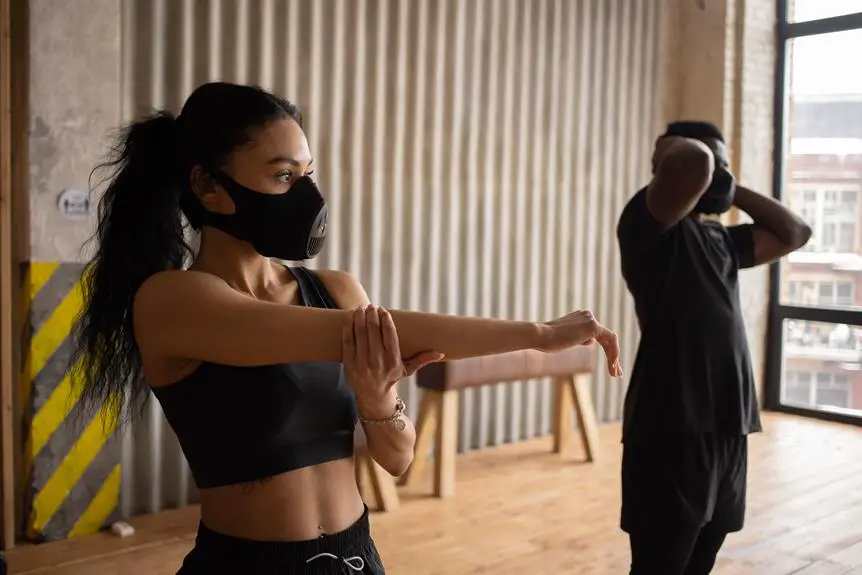Looking to gain a little extra room in your clothes? Did you know that up to 80% of fabric shrinkage occurs during the first wash?
No worries – mastering the art of stretching fabrics is easier than you think. In this guide, you'll discover five simple and effective techniques to stretch fabrics without damaging the material.
From the steam and stretch method to using a fabric conditioner and water soak, these easy tips will help you achieve the perfect fit every time.
Whether it's a snug pair of jeans or a shrunken sweater, these methods will give you the mastery you need to stretch your fabrics with ease.
Key Takeaways
- Steam iron and hairdryer can be used to relax and stretch fabric fibers.
- Soaking fabric in a mixture of fabric conditioner and lukewarm water can help stretch and shape the fabric.
- Stretching spray can be used to relax stubborn or hard-to-stretch fabrics.
- Fabric stretching tools such as blocking boards, sewing gauge, tailor's ham, and steam iron can assist in stretching and shaping fabrics.
Steam and Stretch Method
Using a steam iron is an effective way to stretch fabrics. The steam helps to relax the fibers, making the fabric more pliable and easier to manipulate.
To begin, fill the steam iron with water and set it to the appropriate temperature for your fabric. Lay the fabric on a flat surface and gently press the steam iron over the wrinkled or tight areas. Be sure to keep the iron moving to prevent scorching or overheating the fabric.
As you press the steam iron over the fabric, use your hands to gently stretch the material in the opposite direction of the wrinkles or tightness. The combination of steam and gentle stretching will help to smooth out the fabric and alleviate any tightness. Take care not to pull too hard, as this could damage the fabric.
Continue this process until the fabric is smooth and the desired level of stretch is achieved. The steam and press method is a simple yet effective way to stretch fabrics without causing any damage.
Fabric Conditioner and Water Soak
To stretch fabrics using fabric conditioner and water soak, you'll need to mix a small amount of fabric conditioner with water in a basin or sink. This method is effective for stretching fabrics, especially those made from natural fibers like cotton or wool.
Here are the steps to stretch fabrics using fabric conditioner and water soak:
- Fill a basin or sink with lukewarm water.
- Add a small amount of fabric softener to the water and mix it well.
- Submerge the fabric in the water and let it soak for 15-30 minutes, depending on the fabric type and its thickness.
- After soaking, gently stretch the fabric to the desired size and shape, then lay it flat to air dry.
The fabric softener helps to relax the fibers, making the stretching process easier and more effective. The water soak allows the fibers to expand, aiding in the stretching process. Be mindful of the fabric type and adjust the soaking time accordingly to prevent overstretching.
Use a Stretching Spray
You can effectively stretch fabrics by using a stretching spray. This method can be particularly useful when dealing with stubborn or hard-to-stretch fabrics. A stretching spray helps to relax the fibers in the fabric, making it easier to manipulate and stretch to the desired dimensions. When using a stretching spray, it's essential to follow the manufacturer's instructions carefully to ensure optimal results.
| Fabric Stretching Tools | Description |
|---|---|
| Stretching Spray | Helps relax fibers in fabric |
| Blocking Boards | Used for shaping and drying |
| Sewing Gauge | Measures and marks hems |
| Tailor's Ham | Assists in pressing curves |
| Steam Iron | Removes wrinkles and creases |
In addition to a stretching spray, other fabric stretching tools such as blocking boards, sewing gauge, tailor's ham, and steam iron can be beneficial for achieving professional-looking results. These tools aid in shaping, measuring, pressing, and smoothing the fabric, ensuring that it stretches evenly and maintains its desired shape. When using stretching sprays and fabric stretching tools, always test on a small, inconspicuous area of the fabric first to ensure compatibility and to avoid any potential damage.
Hairdryer and Stretching Technique
A hairdryer can be utilized to apply heat and aid in the stretching process of fabrics, effectively complementing the use of stretching spray. When using the hairdryer and stretching technique, there are a few key steps to keep in mind:
- Apply Heat Evenly: Use the hairdryer on a medium setting to apply heat evenly across the fabric. Moving the hairdryer back and forth over the fabric can help prevent overheating in one spot.
- Stretch Gently: While applying heat, gently stretch the fabric in the desired direction. The heat will help the fibers to relax and become more pliable, making it easier to manipulate the fabric without causing damage.
- Hold the Stretch: Once you have stretched the fabric to the desired length, hold it in place while cooling. This will help the fabric to retain its new shape and prevent it from springing back.
- Test and Repeat: After the fabric has cooled, test the stretch to ensure it meets your desired result. If necessary, repeat the process until the fabric reaches the desired stretchiness.
With these simple steps, the hairdryer and stretching technique can effectively aid in fabric manipulation through heat application.
Wear and Move for Natural Stretching
When wearing and moving in your fabric, allow for natural stretching to occur, aiding in the fabric's flexibility and comfort. Engaging in activities such as yoga poses and Pilates exercises can help your fabric adapt to your body's movements. These exercises encourage gentle stretching, enabling the fabric to mold to your body's contours while maintaining its shape and resilience.
During yoga, positions like Downward Dog and Warrior II naturally elongate the fabric, enhancing its flexibility without causing damage. Similarly, Pilates exercises, such as the Hundred and the Roll-Up, promote gradual stretching, allowing the fabric to accommodate your movements without losing its original form.
By incorporating these activities into your routine while wearing the fabric, you can promote natural stretching, ensuring both comfort and durability. Remember, the key is to allow the fabric to stretch naturally, avoiding excessive force that may compromise its integrity.
Embracing natural stretching through mindful movement not only enhances the fabric's flexibility but also contributes to your overall comfort and ease of movement.
Frequently Asked Questions
Can I Use the Steam and Stretch Method on Delicate Fabrics Like Silk or Lace?
Yes, you can use the steam and stretch method on delicate fabrics like silk or lace. Gently steam the fabric and carefully stretch it to avoid damaging the fibers. This can help to reshape and expand the fabric.
Will Fabric Conditioner and Water Soak Work on All Types of Fabrics, Including Synthetic Materials?
Fabric conditioner and water soak can work on most fabrics, including synthetic materials. However, delicate fabrics like silk or lace may require extra care. Consider using stretching sprays or special finishes to avoid damaging delicate materials.
Are Stretching Sprays Safe to Use on All Types of Fabrics, Including Those With Special Finishes or Coatings?
Yes, stretching sprays are generally safe to use on most fabrics, including those with special finishes or coatings. However, it's important to test the spray on a small, inconspicuous area first to ensure effectiveness and safety.
Can the Hairdryer and Stretching Technique Be Used on Knits and Other Stretchy Fabrics Without Damaging Them?
Yes, the hairdryer technique can be used on knits and other stretchy fabrics without damaging them. However, be cautious with special finishes. Stretching sprays could be an alternative for these fabrics to avoid any potential damage.
Are There Any Specific Types of Movements or Activities That Are Best for Naturally Stretching Fabrics While Wearing Them?
To naturally stretch fabrics while wearing them, try incorporating yoga stretches and aerobic activities. These movements can help gently expand the fabric and improve its flexibility, without causing damage. Remember to move and stretch mindfully.
- Tetron Fabric for Marine Applications: Durability and Use Cases - June 18, 2025
- Tetron Fabric for Outdoor Furniture: Weather Resistance and Care - June 18, 2025
- Tetron Fabric for Wall Coverings: Style and Application Tips - June 18, 2025






